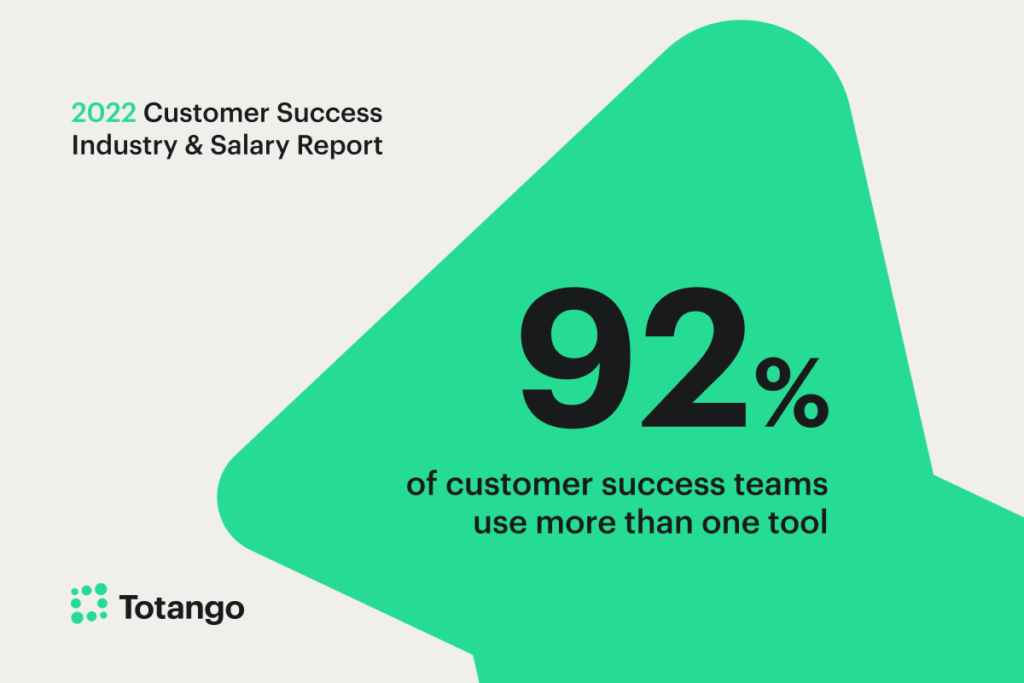Over the past 15 years, we have seen dramatic—even seismic—changes in technology. Whether it’s opening a bank account from the comfort of your couch, navigating an unfamiliar city, or building new relationships, we’re increasingly turning to technology to solve challenges in our personal lives. Businesses, too, now have higher expectations for technology to overcome obstacles and enhance their operations.
In a world where technology is ubiquitous and constantly evolving, why do so many customer success (CS) managers say they don’t have the right tools to bring CS teams into digital transformation and scale-up growth?
In the 2022 Customer Success Industry & Salary Report, we found 34% of CS teams say “a lack of customer success tools” is a moderate challenge. Furthermore, 92% indicated that they use more than one tool to manage their CS programs—presumably to cover the process gaps between each tool.
Additionally, 31% of respondents say they use a custom-built tool, yet not one of them rated it as among their favorites. Let’s look at these challenges in more detail and explore the potential causes and solutions for each.
Too many or too few? The tools conundrum
With over a third of respondents reporting they don’t have the right tools available, finding the most appropriate technology for customer success needs is proving to be a significant challenge for many businesses.
Using several different tools is a sure sign that there is some way to go on the digital transformation journey. For example, with multiple solutions, integration issues are likely to arise, and CS professionals are consigned to a life spent re-keying information between systems. This way of working tends to lead to disjointed workflows, lost time, reduced productivity and increases the likelihood of human error. More seriously, information disconnects can limit visibility into customer adoption and health.
This information gap can have wider consequences, especially since CS teams must now work more closely than ever with colleagues in other areas of the business—from marketing and sales to product design and IT. For example, as the traditional one-and-done handoff of pre- to post-sales gives way to a continuous cycle of managing and optimizing customer journeys to drive retention and growth, it’s crucial for CS and sales teams to collaborate effectively. If your technology makes it hard for different departments to share information, customer insight, and ideas, then you leave the door wide open to competitors.
Additionally, one of the most desirable CS capabilities is predictive analytics. A reactive approach to customers was singled out as the core issue facing many companies, with 37% of respondents naming this as a major challenge. Data trapped in siloed applications, or cut-and-paste to spreadsheets, will offer extraordinarily little by way of analytical capability. Naturally, if you can spot trends, you can take prompt action to deliver value, boost customer health, and drive growth.
All these factors put the brakes on CS digital transformation and scale-up growth.
Breaking free from in-house solutions
In many other business departments, such as finance, HR, logistics, and marketing, companies have turned away from in-house solutions. Wherever possible, corporations are focusing on their core areas of excellence, supported by best-of-breed software vendors.
Very often, solutions are cloud-based, with slick, intuitive services that can be enabled at the tap of a few buttons. Similarly, at the corporate level, the finance department often prefers the cloud subscription model, as it removes the need for capital expense and cuts the operational costs of infrastructure, data centers, IT support, and more.
For the CS team, all the same goals apply. Clearly, the most efficient and effective way to eliminate cut-and-paste friction is to find a single solution that covers all of the core CS functionality. Rather than struggling in isolation with self-built technology, by switching to a single best-of-breed strategy you can take advantage of the best practices and processes developed by the wider user community.
Creating a single source of truth
Importantly, vendor solutions like Totango are designed to scale easily and rapidly, integrate with your data sources, and provide a unified view of your customers. With every customer engagement on a single platform, it becomes easy to design, build, run, and measure your projects, and orchestrate winning customer experiences, consistently and at scale.
For example, individual working lives are hugely enhanced by eliminating tedious hopping from one system to the next. With everyone working from the same curated data, error rates decline and productivity soars. And the single-source-of-truth approach—with verified, centralized data—enables the implementation of new analytical capabilities. These include artificial intelligence and machine learning, which can reveal hidden patterns that help predict behavior—one of the key priorities unearthed by the Totango survey.
By replacing multiple-vendor and in-house systems with a single, integrated solution, CS teams can move rapidly along the digital transformation journey. And while there will be “digital transformation angst” as old ways of working give way to the new, the benefits and value are quickly realized.
Enterprises at the forefront of CS have discovered that achieving the best customer outcomes requires all parts of the business to align towards this goal—and technology choices can make or break your ability to get everyone in the organization involved in customer growth. To learn more about how Totango can help you to integrate CS into every part of your business, click here now.

